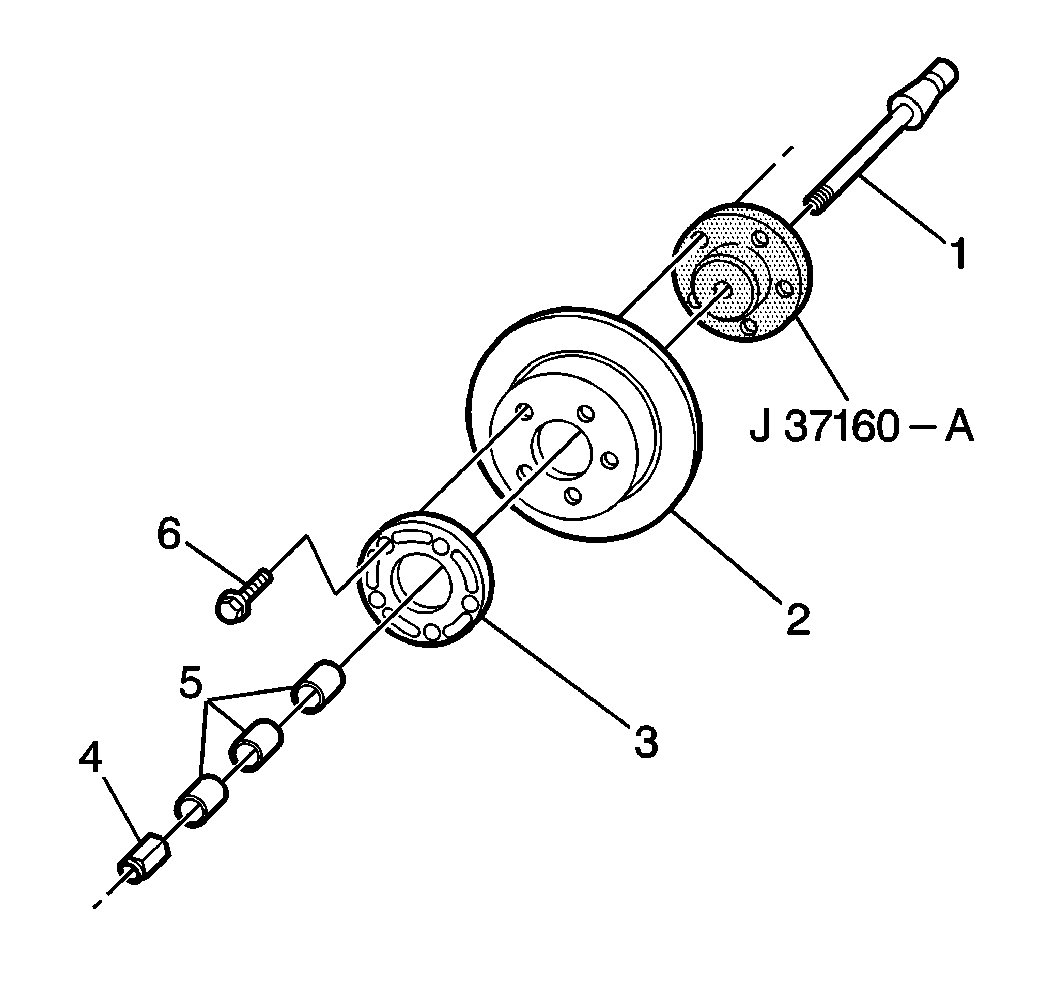Tools Required
J 37704 Disc Brake Lathe
Notice: Do not refinish parking brake drum surface of rotor. Refinishing will result in reduced performance of parking brake.
The following two procedures are recommended and achieve adequate results using two different off-vehicle disc brake lathes. If any other lathe is used, follow that lathe's instructions and recommendations:
Ammco Brake Lathe®
Refer to the manufacturer's instructions for all initial setup and cutting procedures.
Accu Turn Brake Lathe®
GM Dealer Equipment (One Cut Refinishing Procedure)
Refer to the manufacturer's instructions for all initial setup and cutting procedures.
Nondirectional Finishing
Ensure that the rotor surface is nondirectional by dressing the rotor surfaces with one of the following sanding disc tools (or equivalent) using 120 grit aluminum oxide sandpaper:
| • | Ammco® 8750 Safe Swirl Disc Rotor Grinder |
| • | Accu Turn® 433170 Non-Directional Swirl Finisher |
Use the following procedure for nondirectional finishing:
- Sand each rotor surface with moderate pressure for a minimum of 60 seconds.
- With the rotor turning at the equipment manufacturer's highest recommended cutting speed, sand each rotor surface for a minimum of 60 seconds using moderate pressure.
- After the rotor has been sanded, clean each surface with denatured alcohol or a suitable brake cleaner.
If the brake lathe is not equipped with an adequate nondirectional finishing tool, use a sanding block with 150 grit aluminum oxide sandpaper.
The finished rotor surface should be as close as possible to that of a new rotor. Failure to obtain the best possible rotor finish may affect braking performance.
Rotor Mounting Adapter
Tools Required
J 39144 Brake Rotor Mounting Adapter
- Inspect all the mounting hardware for the following conditions:
- Inspect the rotor (2). Ensure that the mounting surface is clean and free of nicks.
- Measure the lateral runout. Refer to Brake Rotor Lateral Runout Check .
- Measure the thickness variation. Refer to Brake Rotor Tolerance .
- Mount the J 39144 on the spindle arbor. Use a suitable combination of spacers (5) or collets in order to tighten the J 39144 to the arbor. Whenever you use lathes with a 7/8 inch spindle arbor, use an adapter sleeve with the J 39144 . Do not use an adapter sleeve with lathes using a 1 inch spindle arbor.
- Mount the rotor (2) onto the J 39144 .
- Mount the clamp plate (3) and five nuts (6). You may install and remove the rotor (2) while the J 39144 is mounted on the machine spindle.
- Install a silencer band on to the rotor (2).
- Use the following procedure in order to verify correct installation of the rotor:
- If the rotor is mounted properly, continue with normal methods in order to resurface the rotor.
- If the witness mark does not extend three quarters of the way around, repeat Steps 1 through 9.

Notice: Whenever the brake rotor has been separated from the wheel bearing flange, clean any rust or foreign material from the mating surface of the rotor and flange with the J 42450 hub cleaning kit. Failure to do this may result in increased lateral runout of the rotor and brake pulsation.
| • | Rust |
| • | Nicks |
| • | Dirt |
| • | Abnormal Wear |
| • | Ensure that all components are clean and in good condition. |
Notice: Use the correct fastener in the correct location. Replacement fasteners must be the correct part number for that application. Fasteners requiring replacement or fasteners requiring the use of thread locking compound or sealant are identified in the service procedure. Do not use paints, lubricants, or corrosion inhibitors on fasteners or fastener joint surfaces unless specified. These coatings affect fastener torque and joint clamping force and may damage the fastener. Use the correct tightening sequence and specifications when installing fasteners in order to avoid damage to parts and systems.
Tighten
Tighten the nuts in a cross pattern to 34 N·m (25 lb. ft.).
| 9.1. | Bring the tool bit up and touch off when the machine is running. |
| 9.2. | Stop the machine and check the witness mark. |
If the mark extends three quarters of the way around, the rotor is mounted properly.
